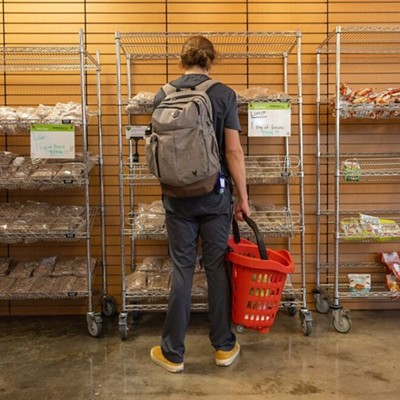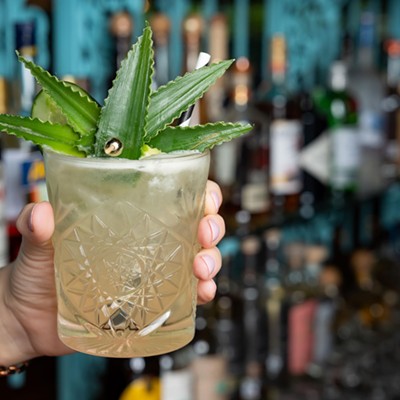Two weeks before Thanksgiving, I had my normal dividing-up-Thanksgiving duties with the father-in-law. After picking the side dishes, he asked me if I could make a second main dish meat to go along with his turkey. No problem, I thought, so I offered to make a lamb roast. "Can you make a ham instead?" he asked. In some sort of shock (being Jewish, albeit not-so-observant), I agreed. In an effort to help some family members with preservative allergies, I decided to make a fresh ham. I mean, if I was going to do something I've never done before, why not go all out?
Since asking friends and family members yielded nothing but a "don't you just heat what's in that package?", a little Googling was in order. I came across this recipe on Cooking.com, which seemed fairly promising. I went to H-E-B and ordered a ham, with little help from the meat counter clerk, who spent a great deal of time staring blankly at me while I blundered through my order. When I asked him how big a fresh ham actually is, he said it would be about 10 pounds. No big deal, I thought. This is not too much larger than the recipe calls for.
A couple of days later, I went back to H-E-B to pick up my pork. When I got there, my ham was 24 pounds. Really.
I asked if they had any smaller ones, and of course, they didn't. Since there was now pretty much no way this hunk of meat was going to fit in any pot or bucket I had in my apartment (nor could they cut it in half because they were cleaning their machines), I had to find a bucket in the store that would fit my ham for brining. It was still much less cost-wise than my normal lamb roasts (about $1 a pound), but it was an insane amount of meat.
I attempted to follow directions, but since this was the whole ham and not half (like the lovely photo from the recipe website was), I was unable to stand it up, not to mention, I never got to add the second gallon of water to the brine. Still, the ham brined for 24 hours, even though I had to rotate it a couple of times to make sure it all swam for a bit. It thankfully still fit in my father-in-law's oven, and took about four hours finish.
The finished product was nothing like the salty and sweet packaged meat most families are accustomed to. This was an amazingly juicy gigantic pork roast, and it was fit for a large family gathering. The skin and fat, once glazed, turned into pig-fat candy, and it was a fight to make the family not pick it off and eat it all. The flavors were not amazingly complex -- more simple and well balanced, they were a nice mix of sweet and savory, with the meat being delightfully flavored. The poor turkey was near ignored while my extended family sat around and picked meat off the roast. Most importantly, it was requested I make it again and no one had any allergies when consuming it. Sorry, Rabbi, this recipe is a keeper...
Tips: Unless you are feeding a family of 15-plus, see if the butcher will either sell you half a ham or at least cut it in half for you so you can make the other half at another holiday. Get a big, big bucket. Also if you get a really fatty ham (if you have the option to choose), that means more tasty pig fat. If you use the whole ham, just place the fat side up and double the rub and glaze.
Roast Fresh Ham
For the Roast: 1 fresh half ham bone-in with skin, 6 to 8 pounds, preferably shank end, rinsed 1 cup apple cider 2 cups packed dark brown sugar or light brown 5 whole cloves
For the Brine: 4 cups kosher salt or 2 cups table salt 3 cups packed dark brown sugar or light brown 2 heads of garlic cloves separated, lightly crushed and peeled 10 bay leaves (I used fresh bay leaves) 1/2 cup whole black peppercorns, crushed For the Garlic and Herb Rub: 1 cup fresh sage from 1 large bunch, packed lightly (I was actually unable to find the fresh stuff, so I used about 1/4 c dried sage) 1/2 cup fresh parsley from 1 bunch 8 medium cloves of garlic 1 tablespoon kosher salt or 1 1/2 teaspoons table salt 1/2 tablespoon ground black pepper 1/4 cup olive oil
Directions: Carefully slice through skin and fat with serrated knife, making 1-inch diamond pattern. Be careful not to cut into meat. Bring cider, brown sugar, and cloves to boil in small nonreactive saucepan over high heat; reduce heat to medium-low and simmer until syrupy and reduced to about 1 1/3 cups, 5 to 7 minutes. (Glaze will thicken as it cools between bastings; cook over medium heat about 1 minute, stirring once or twice, before using.)
In large (about 16-quart) bucket or stockpot, dissolve salt and brown sugar in 1 gallon hot tap water. Add garlic, bay leaves, black pepper, and 1 gallon cold water. Submerge ham in brine and refrigerate 8 to 24 hours.
Set large disposable roasting pan on baking sheet for extra support; place flat wire rack in roasting pan. Remove ham from brine; rinse under cold water and dry thoroughly with paper towels. Place ham, wide cut-side down, on rack. (If using sirloin end, place ham skin-side up.) Let ham stand, uncovered, at room temperature 1 hour.
Meanwhile, adjust oven rack to lowest position and heat oven to 500 degrees. In workbowl of food processor fitted with steel blade, process sage, parsley, garlic, salt, pepper, and oil until mixture forms smooth paste, about 30 seconds. Rub all sides of ham with paste.
Roast ham at 500 degrees for 20 minutes. Reduce oven temperature to 350 degrees and continue to roast, brushing ham with glaze every 45 minutes, until center of ham registers 145 to 150 degrees on instant-read thermometer, about 2 1/2 hours longer. Tent ham loosely with foil and let stand until center of ham registers 155 to 160 degrees on thermometer, 30 to 40 minutes. Carve and serve.
Recipe reprinted by permission of America's Test Kitchen. All rights reserved. Date Added: 01/01/2008
Original recipe found here.





